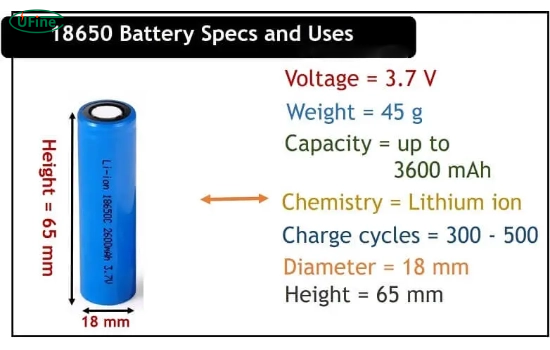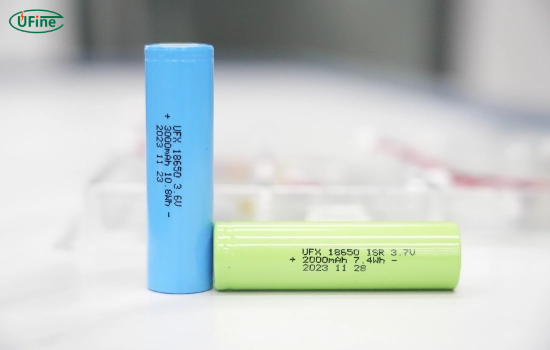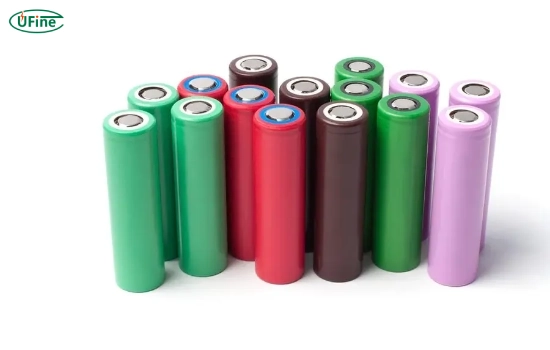The 18650 rechargeable battery stands as a versatile powerhouse in today’s tech landscape. Primarily renowned for its size, capacity, and robust performance, this lithium-ion cell has revolutionized portable power solutions. In this comprehensive guide, we delve deep into the nuances of the 18650 battery, uncovering its specifications, applications, care tips, and more, to empower users in making informed decisions and maximizing their battery efficiency.
Part 1. What is an 18650 rechargeable battery?
An 18650 rechargeable battery is a cylindrical lithium-ion cell characterized by its size: 18mm in diameter and 65mm in length. This rechargeable power source boasts a high energy density, allowing it to store substantial amounts of charge relative to its size. These batteries operate within a voltage range of approximately 3.6 to 3.7 volts, with varying capacities typically spanning from 1800mAh to 3500mAh. Renowned for their versatility, these cells serve as a ubiquitous power solution across a diverse array of portable electronic devices due to their rechargeable nature and robust performance capabilities.
Part 2. 18650 Battery specs
Dimensions:
- Diameter: 18mm
- Length: 65mm
Chemistry:
- Lithium-ion (Li-ion)
Nominal voltage:
- 3.6 to 3.7 volts
Capacity range:
- Typically between 1800mAh to 3600mAh
Energy density:
- High energy density enabling efficient charge storage
Discharge rate:
- Varies per model and brand
- Higher discharge rates enable rapid power delivery
Chemical composition:
- Lithium Cobalt Oxide (LiCoO2), Lithium Manganese Oxide (LiMn2O4), Lithium Iron Phosphate (LiFePO4), etc.
Cycle life:
- Usually between 300 to 500 charge-discharge cycles
Operating temperatures:
- Typically -20°C to 60°C (-4°F to 140°F)
- Performance may vary at extreme temperatures
Charging voltage:
- Standard charging voltage: 4.2 volts
- Recommended cut-off charging voltage: 4.2 to 4.3 volts
Discharge cut-off voltage:
- Typically between 2.5 to 3.0 volts for safety and battery longevity
Maximum continuous discharge current:
- Varies between 5A to 30A depending on the battery model
Watt-hour (Wh) rating:
- Calculated by multiplying the voltage by the ampere-hour (Ah) rating
- Example: A 3.7V 2500mAh battery has a 9.25Wh rating (3.7V * 2.5Ah = 9.25Wh)
Charging method:
- Requires compatible chargers designed for lithium-ion batteries
- Some models feature built-in protection circuits for safe charging
Weight:
- Generally ranges from 45 grams to 50 grams
Compatibility:
- Varies based on the device’s voltage and capacity requirements
- Essential to match battery specs with device specifications for optimal performance and safety.
Part 3. 18650 Rechargeable battery advantages and disadvantages
18650 Rechargeable battery advantages
- Voltage Stability: 18650 batteries maintain a relatively stable voltage throughout discharge cycles, ensuring consistent power supply to devices, even under varying loads.
- Low Internal Resistance: These batteries exhibit low internal resistance, enabling efficient energy transfer and reduced heat generation, making them suitable for high-drain devices.
- High Energy Density: With a high energy-to-weight ratio, 18650 batteries offer substantial energy storage capacity relative to their size, ideal for compact devices requiring long-lasting power.
- Rechargeability and Low Memory Effect: These batteries have minimal memory effect, allowing them to be recharged frequently without needing a full discharge, maintaining performance and capacity.
- Durability and Longevity: 18650 batteries are designed for hundreds of charge cycles, offering extended lifespan and reliability for long-term usage.
18650 Rechargeable battery disadvantages
- Safety Concerns and Thermal Runaway: Mishandling or overcharging can cause thermal runaway, leading to increased temperatures, leakage, or rupture, posing safety hazards.
- Performance Degradation Over Cycles: Despite durability, repeated charge-discharge cycles lead to gradual capacity loss and decreased voltage output, affecting overall performance.
- Complex Charging Requirements: Charging requires precise voltage and current control; improper charging methods or using incompatible chargers can damage the battery or reduce its lifespan.
Part 4. 18650 Battery uses
1. Laptops, tablets, and power banks
These batteries are well-suited for portable computing devices due to their high energy density and compact size. They efficiently power laptops and tablets while serving as rechargeable energy sources in power banks for on-the-go charging.
2. Flashlights and torches
Known for their consistent power output, 18650 batteries are ideal for powering high-performance flashlights and torches. Their ability to maintain a stable voltage throughout discharge ensures prolonged and reliable illumination.
3. Power tools
18650 batteries, with their low internal resistance and ability to deliver high currents, are commonly used in cordless power tools. Their efficiency and longevity make them suitable for demanding tasks in construction and DIY projects.
4. Vaping devices and portable fans
These batteries find use in vape mods and e-cigarettes, providing a consistent and rechargeable power source. They also power portable fans efficiently due to their high energy density and rechargeable nature.
5. Medical devices
In portable medical devices and hearing aids, the compact size and reliability of 18650 batteries make them suitable for powering essential healthcare equipment with consistent performance.
6. Electric vehicles (EVs) and e-bikes
Integrated into battery packs for electric cars, scooters, and bicycles, 18650 batteries offer high energy density and rechargeability, making them essential for efficient and sustainable mobility solutions.
7. UPS and solar energy storage
These batteries serve as reliable backup power sources in UPS systems and efficiently store solar energy due to their ability to withstand numerous charge-discharge cycles.
8. Robotics, drones, and custom power banks
Their compact size and consistent power output make 18650 batteries suitable for DIY robotics, drone projects, and custom power banks, catering to diverse hobbyist and experimental needs.
Part 5. 18650 Rechargeable battery care tips
Proper charging habits
- Use compatible chargers: Always employ chargers specifically designed for 18650 batteries to prevent overcharging or damaging the cells.
- Avoid overcharging: Once fully charged, promptly remove batteries from the charger to prevent overcharging, which can degrade battery health.
- Monitor charging: Regularly check on batteries while charging to ensure they aren’t overheating, as excessive heat can compromise their lifespan.
Storage guidelines
- Ideal conditions: Store batteries in a cool, dry place away from direct sunlight and extreme temperatures. Aim for temperatures between 20°C to 25°C (68°F to 77°F) for optimal storage.
- Avoid heat and moisture: Prevent exposing batteries to extreme temperatures, moisture, or fire, as these conditions can damage the battery or lead to safety hazards.
- Avoid prolonged inactivity: If storing batteries for an extended period, ensure they have a partial charge (around 50%) to prevent complete discharge.
Usage
- Regular usage: Regularly use and recharge batteries to prevent complete discharge, which can lead to capacity loss.
- Match batteries: When using multiple batteries in a device, ensure they have similar capacities, ages, and charge levels to prevent uneven discharging.
Handling and safety
- Avoid physical damage: Protect batteries from physical damage, including dents or punctures, as these can compromise their integrity and safety.
- Safety circuits: Consider using batteries with built-in protection circuits to prevent overcharging, over-discharging, and short circuits for added safety.
Inspection and maintenance
- Regular inspection: Periodically check batteries for signs of damage, leakage, or swelling. Dispose of damaged batteries safely.
- Clean terminals: Use a dry cloth to clean battery terminals to ensure good contact and prevent buildup that might affect performance.
Part 6. FAQs
-
What is the typical lifespan of an 18650 battery?
The lifespan of an 18650 battery can vary based on usage, charging habits, and environmental conditions. Typically, they last around 2 to 5 years or 300 to 500 charge cycles before experiencing notable capacity degradation. -
Are all 18650 batteries compatible with the same devices?
Not necessarily. While most 18650 batteries share common physical dimensions, they can differ in capacity, discharge rates, and chemistry. It’s crucial to use batteries that meet the device’s voltage and current requirements for safe and efficient operation. -
How should I safely dispose of old or damaged 18650 batteries?
To safely dispose of old or damaged 18650 batteries, consider recycling them at designated battery recycling centers or drop-off locations. Many electronics or battery retailers offer recycling programs for proper disposal. -
What are the signs indicating that an 18650 battery needs replacement?
Signs indicating an 18650 battery needs replacement include reduced capacity, shorter runtime, increased heat generation during charging or discharging, physical damage, or if it fails to hold a charge as effectively as before. -
Can I use 18650 batteries in series or parallel configurations?
Yes, 18650 batteries can be used in series or parallel configurations to increase voltage or capacity, respectively. However, this requires careful attention to matching batteries with similar specifications and using proper precautions to avoid imbalances in the setup.
Related Tags:
More Articles

How to Choose the Right Electric Fence Battery?
Choosing the right electric fence battery is key to security. This guide helps you pick a reliable farm, garden, or animal power source.
What Are Lithium Pouch Cells?
Explore how lithium pouch cells work, their structure, advantages, and uses. Learn from a trusted supplier like Ufine Battery for custom lithium solutions.
The Evolution of Ring Battery Pack Technology in Lithium Battery Manufacturing
Ring battery packs are reshaping lithium battery tech. Discover their evolution, key uses, and why they matter for the future of energy storage.
Lithium vs Lithium Salt: What’s the Difference?
Lithium is a pure metal, while lithium salts are stable battery compounds. Learn their key roles and differences in battery manufacturing.
What You Need to Know About AA 3.6V Lithium Battery
Learn all about AA 3.6V lithium batteries—voltage, size, capacity, uses, and the best replacements. Discover why they’re powerful, and highly reliable.






